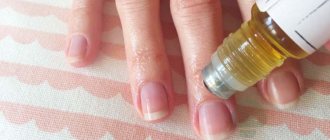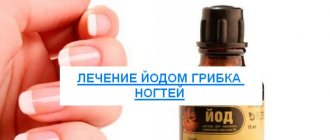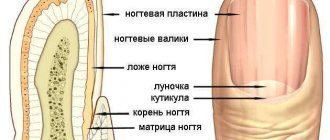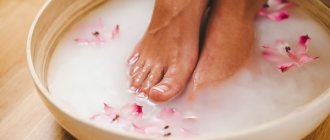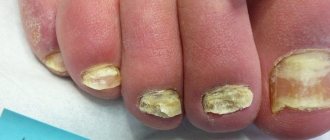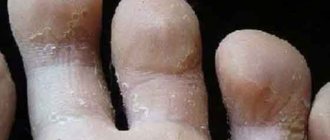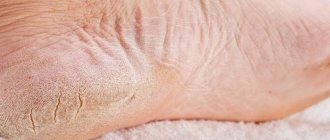Unique properties of celandine
Celandine against nail fungus
The leaves and stems of this herbaceous plant contain many useful substances. Some of them promote nail care - for example, vitamins A and C. Some fight diseases - for example, phytocides and alkaloids. Organic acids are an excellent preventative against microcracks and peeling nails.
You can use celandine to treat nail fungus in different ways:
- Fresh juice is the most valuable product, as it requires a fresh plant every day. Ideal for those who have the opportunity to visit celandine growth sites several times a day.
- Herbal pharmacy collection of celandine. If the disease manifests itself in winter or you are a purely urban resident and do not plan to look for this plant yourself, you can purchase dry leaves and stems of celandine at the pharmacy. It is cheap and sold everywhere (about 50 rubles per pack).
- Tincture of celandine in alcohol. Also sold in pharmacies in dark glass bottles of 30mm, 50mm.
- Celandine oil is concentrated plant juice with additives of healthy oils. An excellent alternative to fresh juice.
Before using celandine to treat nail fungus, they must be prepared.
Pharmaceutical preparations of celandine
Before treating a fungal nail disease, it is necessary to understand the characteristics and effects of medicines based on this plant. Due to the low content of volatile substances in celandine, essential oil is not made from it.
In cosmetology and pharmacology, oil extracts from the flowers of this medicinal plant are used. Celandine oil for nail fungus can be purchased at a price ranging from 1-7.5 USD.
The pharmaceutical oil extract contains almost a complete set of PCS from this herb. This product is used only externally without dilution.
The therapeutic effect is explained by the cauterizing, antimicrobial and keratolytic effects of the drug on the affected skin and horny plates.
Celandine oil extract moisturizes, softens and cleanses the skin and horny formations, eliminates peeling, irritation and dryness.
This oil can cure nail fungus, but before use it is necessary to conduct an allergy test, since celandine can provoke hives. To do this, oil is dripped onto the skin of the wrist and the result is assessed after a quarter of an hour.
If there is no itching, blistering, irritation or redness, then it can be used for treatment.
Preparatory stage
The preparatory stage for treating nails with celandine helps the medicine penetrate the nail as deeply as possible, right up to the lesion. This is the only way you can cope with the fungus and stop its development.
Preparation consists of 3 stages:
- Cut your nails as short as possible.
- Prepare nail baths. To do this, take hot water, pour soda into it at the rate of 1 teaspoon per half liter of water, add a spoonful of shampoo, liquid soap or bath foam. Keep your nails in this bath for 15-20 minutes.
- Dry your feet with a towel. Using scissors and files, try to get rid of thick growths as much as possible.
In addition to baths with soda, you can use baths with hydrogen peroxide, vinegar or chamomile.
Carrying out the preparatory stage is very important, as it allows you to speed up treatment by 2-3 times.
Action
Products based on celandine, or plant juice in its pure form, provide an excellent therapeutic effect in the treatment of mycosis of the feet. The active components quickly penetrate the affected tissues, stop the growth of pathogenic microorganisms, dry wounds, relieve inflammation, and promote rapid tissue regeneration.
As for nail mycosis, the effect depends on the correct preparatory procedures. The dense structure of the nail plate does not allow the active substances to penetrate into the tissues where fungal spores are localized. To eliminate the obstacle, it is necessary to carry out a simple preparatory procedure - steam the skin and nails in a bath, remove as much damaged areas as possible, and sand the top layer. In this case, the layer of keratinized cells is eliminated, and the active components are absorbed by the tissues.
How to use celandine to treat fungus
Celandine is the best remedy for nail fungus
Celandine can be used in several ways to treat fungus. Each of them has its own effectiveness. However, it should be remembered that traditional medicine treatment is best carried out at the initial stage. For more advanced fungus, celandine can only be used as part of complex therapy, and the main method of treatment should be ointments, tablets and other medications prescribed by a doctor.
Celandine ointment
To make an ointment from celandine according to all the rules, you need fresh juice of this plant. The advantage of the ointment is that it can be stored in the refrigerator for quite a long time. So, let's go collect celandine. The main thing you need to know when searching for a medicinal plant is where it grows. Celandine loves moist soil, so it lives abundantly near rivers, lakes, and in lowlands.
Collection is best done with gloves and protective clothing. Or the one you don’t mind – bright orange juice is very difficult to wash off and can ruin things.
We collect celandine with stems, since they contain more juice than leaves. Let's do it quickly. The best and most useful celandine is during flowering. At home, we grind it using a blender and squeeze out the juice using a strainer.
The second ingredient for the ointment is Vaseline. It can be purchased at any pharmacy. Mix Vaseline with celandine juice, mix well, cover with a lid and store in a cool, dark place. This ointment is convenient for lubricating your nails. It can also be used to combat warts, eczema, acne, papillomas and other skin diseases.
If for some reason you do not want to use Vaseline, you can use goose fat as a base for the ointment.
Decoction of celandine
Celandine oil
To prepare a concentrated decoction of celandine, you need to use fresh leaves and stems. If they are not available, a pharmacy preparation will do, but the quality of such a decoction will be lower. So, take the celandine, cut it and put it in a pan. Fill with water so that the leaves are completely submerged. Bring to a boil and reduce heat. Cook over low heat for 5 minutes, then strain the broth. It can be stored in the refrigerator for 10 days. Lubricate your nails with it using a cotton swab 3-4 times a day.
This decoction can be added when steaming the legs to prepare for the use of ointment, and for prevention, and for treating wounds and abrasions. It can replace iodinol and other antiseptics.
Celandine tincture
You can buy celandine tincture at a pharmacy, or you can prepare it yourself.
An important rule: freshly harvested celandine always gives a better effect.
To prepare a celandine tincture with alcohol, you will need a fresh plant and alcohol. Chop the leaves and stems into a glass jar; it is advisable to chop them to 1 cm. Add alcohol, shake thoroughly, close tightly with a lid and store in the refrigerator. The ratio of the volume of leaves to alcohol should be approximately 1 to 2. You can make the solution more concentrated if you plan to use it only to treat the toenail plate, or less concentrated if you expect that you will need skin treatment.
You can apply celandine tincture up to 5 times a day to your toenails for 5 weeks. During this time, you will understand whether celandine is enough for treatment, or you should pay attention to traditional medicine.
Baths with celandine
Celandine - a medicinal plant
Baths with celandine help not only defeat fungus, but also get rid of excessive sweating of the feet, unpleasant odor, calluses, corns and spurs. For a bath of this medicinal plant, a tincture, decoction or fresh herb of celandine is suitable.
A tablespoon of celandine pharmaceutical collection is poured into a glass of boiling water and left under the lid for 40 minutes. Pour the resulting solution into the foot bath. The water temperature should be about 40-50 degrees. Keep your feet for 15-30 minutes depending on the stage of the fungus. To enhance the effect, you can add a spoonful of dandelion, chamomile, and St. John's wort roots to the celandine.
Celandine tincture can also be used for baths against nail fungus. Add a little tincture to hot water. You can also add a teaspoon of iodinol or iodine.
You can also add fresh celandine juice to the bath. To do this, the roots and leaves are ground in a blender and the whole mass, without filtering, is added to water.
For the baths to be beneficial, it is better to use them in combination with antifungal ointment. After the bath, wipe your feet dry, lubricate them with cream and put on warm socks. It is complex therapy that gives the best results in the treatment of toenail fungus.
Celandine oil
Celandine oil is an extremely useful product that you can make yourself. It has the following qualities:
- Regenerating;
- Antipruritic;
- Antifungal;
- Antibacterial;
- Antimicrobial;
- Wound healing.
- Antiseptic;
- Pain reliever;
- Anti-inflammatory.
The oil can be used not only externally, but also internally, but before drinking it, you should consult a doctor.
There are 3 ways to make celandine oil.
- Heat the oil and pour the celandine raw material into it. The flowers of the plant are best suited for these purposes. Close the lid tightly, and after the oil has cooled, place it in a cool, dark place. The oil can be used after 3-4 days.
- The oil and celandine are mixed, placed in a water bath and simmered for about 2 hours, not allowing the oil to boil. This is the most effective way to prepare oil, since in a water bath the plant releases its nutrients better.
- Oil and celandine flowers are mixed and placed in a warm place - for example, under a radiator. After a week, the oil is ready for use.
Apply the drug to the nail plates and you will quickly get rid of the fungus. It can also be rubbed into the skin around the nails to prevent the disease from spreading further. Treat healthy nails with celandine oil for prevention.
Contraindications and side effects
Despite its natural origin, the plant cannot be used in the following cases:
- lactation (partial restrictions);
- pregnancy;
- epilepsy;
- children under 7 years old;
- mental disorders;
- diseases of the cardiovascular system.
Side effects when using celandine are possible only if its dosage is exceeded, including when used externally. For example, applying plant juice to healthy skin often results in serious rashes and irritation, which is why it is recommended to carry out all medical procedures with gloves. Internal use of fresh herbs can cause burns to the mouth and larynx, nausea and vomiting, gastrointestinal bleeding, diarrhea and confusion.
Celandine with iodine
Celandine is also good in combination with other substances. For example, by mixing a solution of celandine with iodinol, you will get a unique remedy against nail fungus. It can be added to baths or applied to nails with a cotton swab 2-3 times a day.
Pros of celandine with iodine:
- low cost of both products;
- naturalness;
- health safety;
- enhancing the effect of both drugs in combination.
When using celandine baths with iodine, remember that iodine dries the skin, so after the procedure, treat the skin of your feet with any cream, and the nails themselves with anti-fungal cream.
Effective recipes
The effect of celandine is enhanced when combined with other active substances.
Celandine with soda
Pour 1 liter of warm water into the bath. Add 1 tbsp. a spoonful of baking soda, the same amount of sea salt. Lower your legs for 30 minutes. The ingredients perfectly soften the skin and nail plate, and promote the exfoliation of dead areas. After completing the procedure, wipe your feet, polish your nails, apply celandine oil or apply a compress from a tincture or decoction. The procedure must be performed daily for 2 weeks.
Celandine, hydrogen peroxide
Make a bath from a decoction of medicinal herbs. Remove damaged areas of the epidermis and nail as much as possible. Treat with hydrogen peroxide and apply celandine oil. Peroxide promotes better penetration of active components into the deep layers and prevents the spread of infection.
Celandine with iodine
There are several variations on how to use these 2 active components. Iodine enhances the therapeutic properties of the herb, additionally strengthens the nail plate, and promotes the growth of a full-fledged new nail.
- Make a paste from dry or fresh herbs, add a few drops of iodine. Apply to gauze and apply a compress to the affected area.
- Make a bath using a decoction of celandine. Apply iodine with a brush to the nail plate.
- Add a few drops of iodine to celandine oil, soak cotton wool, and apply as a compress overnight.
- Add 1 teaspoon of baking soda, salt, and 10 drops of iodine to 1 liter of warm water. Place your feet in a healing bath for 20 minutes. Upon completion, treat with celandine oil.
The duration of the course is at least 2 weeks. The procedure must be repeated twice a day.
Lemon with celandine
Squeeze lemon juice, mix with celandine oil, apply to the affected nail. Lemon softens the top layer, allowing the active components to be absorbed into the localization of fungal spores.
Instead of lemon, you can use table vinegar or apple cider vinegar. They wipe the nail, after a few minutes they polish the nail, apply celandine oil, make compresses and lotions.
Celandine with hydrogen peroxide
Celandine tincture
A unique way to destroy toenail fungus is to use celandine with hydrogen peroxide. Mix 1 to 1 peroxide and celandine tincture (juice and oil are also suitable) and lubricate the affected areas of the nails with a cotton swab. Both drugs will penetrate into areas of inflammation faster if you first take a salt bath. Take 1 tablespoon of sea salt per liter of water. The duration of the bath will be about 30 minutes.
Hydrogen peroxide can be used before applying celandine juice.
What do you need to remember?
There are several requirements that you should remember even before treatment. Basic rules for using celandine:
- remember that the plant is poisonous, carry out all processes with gloves, if possible try not to get the juice on the healthy dermis, especially in areas with increased sensitivity - an aggressive liquid can cause serious harm to the skin;
- strictly follow the recommended dosages - exceeding the aggressive herb will cause side effects;
- use an integrated approach to treat fungus - alternately treat the disease with different compounds;
- if there are no results, see a doctor, treat with pharmaceutical drugs, use traditional medicines as an auxiliary therapy.
Preliminary testing will help to partially avoid troubles - apply a few drops of the prepared product to the skin (do not touch sensitive areas), wait 1-2 hours. The absence of irritation is a signal to carry out procedures.
The use of celandine at all stages of fungal diseases is an effective treatment option for a disease dangerous to nails. You should not delay the use of home remedies - it is recommended to use decoctions, tinctures, and oils even at the first signs of illness.
The active elements contained in plant materials act in several directions at once - they regenerate tissues, destroy mycoses, stop the spread of inflammation and infections, and relieve pain in the dermis near the nail.
Celandine with lemon
Since fungi cannot reproduce in an acidic environment, citric acid, boric acid, and lemon juice are used to combat them. The latter has a gentle effect and can be used to treat fungus even in children. Celandine juice will enhance the effect and allow you to cure the disease much faster.
To prepare the medicine, you will need a teaspoon of lemon juice and half a teaspoon of celandine juice. Mix well. Prepare a foot bath, add hydrogen peroxide and most of the mixture. Soak your feet in the bath for 20 minutes, then wipe them dry with a towel. Apply the remaining juice to your nails. Wear clean cotton socks.
Try not to wear shoes for at least 2 hours after using this product.
Rationale for the method
Celandine is a herbaceous plant widely used in folk medicine, especially for the treatment of dermatological problems.
Contains vitamins A, C, organic acids, phytoncides and alkaloids. It is characterized by antiseptic and antifungal effects, relieves allergic itching, and inhibits inflammatory processes.
In what form does it come?
- Fresh plant sap is the liquid released at the site where the stem is broken. It has a pronounced “cauterizing” effect and has a fungicidal effect on fungi (leading to their death). Turns the skin orange. Toxic in high concentrations, can cause superficial burns, irritation and peeling . Suitable for external treatment of diseased nails.
- Herbal mixture (about 50 rubles/pack) for foot baths .
- Celandine oil (about 80 rub. 30 ml) for external treatment of nails.
- Alcohol tincture of celandine juice (about 200 rub. 50 ml) for external treatment of nails or adding to baths .
Celandine grows everywhere, it is easy to collect it yourself and make an ointment or tincture at home.
When to use the method
- in the initial stages of onychomycosis;
- in complex therapy of nail fungus;
- for disease prevention.
Advantages and disadvantages
Pros:
- low price and availability;
- organic origin, naturalness;
- relative safety for health.
Minuses:
- insufficient effectiveness of celandine as an independent remedy;
- staining nails and skin (especially when using fresh juice).
Treatment with celandine of the initial stage of nail fungus
At the initial stage, toenail fungus can be treated with traditional methods much faster than when the disease is already advanced. How to determine the initial stage of toenail fungus? Look out for the following signs:
- The nail has slightly changed color;
- The nail has become more brittle, but almost not thickened;
- There was a slight itch.
If these signs are moderate, it makes sense to try to cure the fungus with folk remedies. Using a cream or ointment against fungus will speed up the healing process.
Causes of fungus
The fungus is a contagious disease, so it is easy to become infected in crowded places, in public places and using the things of infected people. Fungal cells are found on personal hygiene items such as scissors, files, slippers, shoes and bedding.
If it is customary in a family to use one towel and one of the family members suffers from a fungus, then the risk of infection is very high. In addition, the fungus occurs more quickly with a genetic predisposition, malfunctions in the body and disorders of the immune system (immunodeficiency is often associated with AIDS, excessive use of antibiotics, hormonal agents, ointments, sprays).
In diabetes mellitus, glucose levels increase, which increases the number of pathogenic microorganisms. This leads to skin fungus. Fungus on the mucous membranes appears during chronic infection of the sinuses and during menopause in women, when the mucous membranes dry out and hormonal levels change; with microtrauma on the cheeks and lips, tissue fluid is released, which promotes the development of fungus. The disease develops with diseases of the central nervous system, allergies, poor metabolism and vitamin deficiency.
Compound
The official status of the drug was assigned to it due to its saturation with alkaloids. These are moderately poisonous compounds on the central nervous system, epidermis and mucous membranes of humans, and lethal compounds for most pathogens, one of the types of natural antibiotics. There are more than 20 species of them in celandine.
In addition to them, the composition of the herb is notable for the abundance of vitamin C (1 g per 100 g), which is an immune stimulant. Celandine also contains other food acids - succinic, malic, citric.
The yellow color of the flowers and the orange sticky juice released at the break of the stems hints at the presence of a significant proportion of carotenoids - the “raw materials” for the production of retinol. The plant is useful for all tissues formed by horn cells - nails, epidermis and hair equally.
Bioflavonoids are also found in slightly smaller amounts in celandine. These are also natural antiseptics with antioxidant properties, generally safer for humans compared to alkaloids.
Features of treatment with folk remedies
Now you know whether it is possible to treat nail fungus with celandine, and in what ways this is done. But before you try any of the above recipes, we would like to give you some valuable tips.
1. You should not practice celandine treatment by taking a decoction of the plant’s flowers orally - this can be extremely dangerous to health, as it threatens paralysis of the nervous system.
2. Traditional medicine is good, but do not forget about therapy with specialized drugs prescribed by the doctor. Only in combination with basic treatment will traditional medicine give the fastest and best effect. It is also important that when developing a treatment regimen, the doctor selects the optimal treatment options, so it is strongly recommended not to evade his instructions.
3. Before using any product, be it a compress or ointment, it is recommended to steam your feet well and, if possible, remove the part of the nail affected by the fungus.
4. Celandine is a poisonous plant (by the way, this is why you should not abuse a decoction based on the plant’s flowers for oral administration), so it must be used with extreme caution. An overdose causes terrible phenomena, so you must always strictly adhere to the indicated dosage.
Healing properties of the decoction
The use of celandine in folk medicine against nail fungus in the form of a decoction is widely known. It is easy to make and use:
• take 5 heaping tablespoons of raw materials; • pour into a large bowl and pour 1.5 liters of boiling water; • leave to infuse for 15 minutes; • pour into a basin, add a couple of glasses of water, the temperature of which should be about 65 degrees; • dip your feet in the healing liquid and leave for 15-30 minutes.
To enhance the effect, it is recommended that after steaming, rub your feet (nails) with antifungal ointment prescribed by your doctor.
Making baths from the decoction
In this method, you can use a dried plant, which is sold in any pharmacy. This is a more gentle option for treating nail and foot fungus, so it is not forbidden to take baths every day. Unlike tincture and oil, the decoction will not dry out the skin or cause an allergic reaction.
How to cook? Take 1.5 liters of water and add 2 tablespoons of dry raw materials to it. Bring to a boil and then remove from heat. You can either wait for the infusion to cool or dilute it with cold water. It is also allowed to pour boiling water over the grass and wait 25-35 minutes.
How to use? You should carefully lower your feet into the bath, but the broth should be hot. The skin of your feet should steam properly, but control the entire process so as not to get burned.
Keep your feet for 15-20 minutes, periodically adding hot water.
After completing the procedure, it is important to pat your skin dry with a towel and put on clean, warm socks.
Please note that all personal hygiene items should belong only to you, because nail fungus can be transmitted through contact with contaminated items. After each bath, the dishes should be washed thoroughly, and socks and towels should be washed in hot water.
Contraindications to the use of celandine
Despite the fact that the component is intended to be used in home treatments - baths or compresses, it has some restrictions for health reasons. It is important to take them into account in order to prevent the occurrence of an allergic reaction, low effectiveness of the procedure or tissue irritation.
Few contraindications are prescribed:
- Allergic reaction.
- Pregnant women (especially in the first trimester should not use it, as there is a risk of affecting the hormonal system).
- If you have diseases of the respiratory, cardiovascular or nervous system.
- In the presence of open wounds.
- Under 6 years of age.
It is often not recommended to use the decoction while breastfeeding. This is due to the risk of its concentration getting into breast milk, which will affect the child’s health.
Be careful when following the dosage of using the herb, as exceeding its norm can lead to damage to the nail structure and the progression of fungus.
You cannot use the leaves for a long time; it is recommended to alternate it with the use of other elements for homemade masks and store-bought ointments to maintain the health of your natural manicure.
